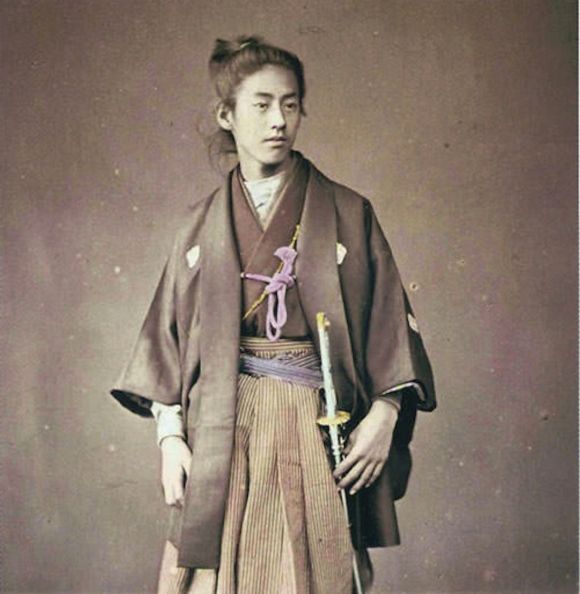It turns out that along with sword fighting and horseback archery, a strict grooming routine has long been part of the samurai tradition.
The practice of Japan’s warriors and men of the ruling class taking pains to look their best stretches back to at least the Heian period, which lasted from 794 to 1185. Wealthy individuals, whether male or female, would whiten their face with cosmetics, likely stemming from paleness being a sign their social status precluded them from laboring outdoors and developing the natural tan of the less financially well-off.
Heian aristocrats would also shave their eyebrows, then repaint them at an exaggeratedly high point on their foreheads. This was done to make the face appear more expansive, which at the time was considered to lend a regal air.
Much of the imperial decadence of the Heian era fell out of favor during the following Kamakura period, when Japan came under the control of its first feudal Shogun lord, and a new focus on austerity affected everything from architecture to religion. Much as with modern military men, though, it was still essential that a samurai look presentable at all times, so as not to bring shame upon himself with his slovenliness.
The prominent Hojo samurai clan even went so far as to include the following as part of its familial code:
“Before going out in public, you must look in the mirror and check thoroughly that your clothes are not twisted or otherwise out of position. However, once in public you should by no means be seen adjusting your clothing.”
The concept of male grooming really took off one the Edo period started in the 17th century, which brought an end to the consecutive centuries of civil war that had gripped Japan until then. Needing less time for fighting gave Japanese males more time for loving, and this period saw the growth of the Yoshiwara pleasure quarter on the outskirts of Edo, the city which would later be renamed Tokyo.
Yoshiwara wasn’t only about the pleasures of the flesh, though. It was also the epicenter for developments in fashion and the arts, so men headed there wanted to make sure to show that they were up on the latest trends, which they could brush op on by reading some of the Edo era’s regularly published male fashion guides.
At the beginning of the Edo period, beards were in fashion, so much so that fake facial hair was sold for the young man about town who didn’t have the time or genes necessary to produce more than a fine layer of stubble. The Edo period lasted for more than 260 years, though, so eventually popular tastes shifted to the exact opposite, and a clean-shaven face was considered the most handsome.
As time went by, this evolved into a dislike of body hair in general, and it’s said that the men of Edo would diligently remove as much as necessary so that none jutted out from behind their loincloth, which was considered an unsightly fashion faux pas.
Edo Japan even had its own Altoids substitute, as even before the proliferation of deliciously pungent foods like curry and pot stickers, breath care was considered an essential part of proper social etiquette. The Edo man who wanted his breath to smell as sweet as the nothings he planned on whispering to his lover would chew on a few plum blossoms before their romantic meeting.
Make-up was also often used by fashionable males in the Edo period, something which is said to have been common in Japan up until its tremendous modernization and internationalization push that began with the Meiji restoration in 1868. With the feudal period over, Japan began to align itself with other countries’ concepts of masculine fashion, leaping into the 19th-century beard craze with both feet.
It’s been said the only constant is change, though, and in Japan now a three o’clock shadow is about as far as most Japanese men will go, as the full-on five o’clock version is just too bushy for contemporary tastes. We’re not sure what the future holds, but in the meantime, we recommend taking the best points of all historical periods to come up with your own unique style.
Source: Naver Matome
Read more stories from RocketNews24. -- Revealed! Japan’s top 10 handsome samurai -- Samurai bling: Crazy armor and helmets from medieval Japan -- Hiragana art: Creating pictures using the Japanese syllabary
© RocketNews24 Take our user survey and make your voice heard.
Take our user survey and make your voice heard.















5 Comments
Login to comment
kimuzukashiiiii
This article is pretty interesting! And the Samurai is kind of cool... I wonder what they would think of todays herbivore men?
GalapagosnoGairaishu
There's good grooming and then there's narcissism, and I'm not entirely sure where the dividing line falls.
inakaRob
"would diligently remove as much as necessary so that none jutted out from behind their loincloth, which was considered an unsightly fashion faux pas."
umm... how was this popular in Edo era, but not in MODERN times??!?! Talking about both J-gals and J-guys. Trim the hedges please!
Kittychosen
If only modern day salarymen would do the same before taking the train in rush hour...